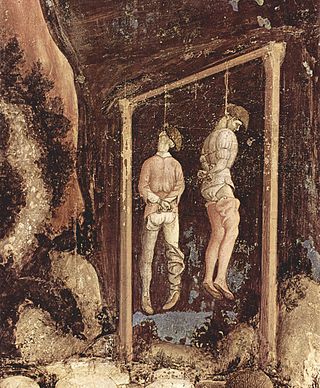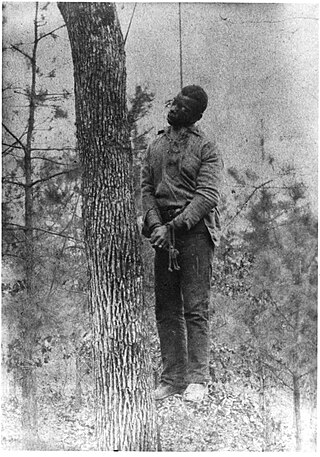A hate crime is crime where a perpetrator targets a victim because of their physical appearance or perceived membership of a certain social group.

The bowline is an ancient and simple knot used to form a fixed loop at the end of a rope. It has the virtues of being both easy to tie and untie; most notably, it is easy to untie after being subjected to a load. The bowline is sometimes referred to as king of the knots because of its importance. Along with the sheet bend and the clove hitch, the bowline is often considered one of the most essential knots.

Hanging is killing a person by suspending them from the neck with a noose or ligature. Hanging has been a common method of capital punishment since the Middle Ages, and is the primary execution method in numerous countries and regions. The first known account of execution by hanging is in Homer's Odyssey. Hanging is also a method of suicide.

Lynching was the widespread occurrence of extrajudicial killings which began in the United States' pre–Civil War South in the 1830s and ended during the civil rights movement in the 1950s and 1960s. Although the victims of lynchings were members of various ethnicities, after roughly 4 million enslaved African Americans were emancipated, they became the primary targets of white Southerners. Lynchings in the U.S. reached their height from the 1890s to the 1920s, and they primarily victimized ethnic minorities. Most of the lynchings occurred in the American South, as the majority of African Americans lived there, but racially motivated lynchings also occurred in the Midwest and border states. In 1891, the largest single mass lynching in American history was perpetrated in New Orleans against Italian immigrants.

Bushcraft is the use and practice of skills, thereby acquiring and developing knowledge and understanding, in order to survive and thrive in a natural environment.

The bottle sling is a knot which can be used to create a handle for a glass or ceramic container with a slippery narrow neck, as long as the neck widens slightly near the top.
The Jena Six were six black teenagers in Jena, Louisiana, convicted in the 2006 beating of Justin Barker, a white student at the local Jena High School, which they also attended. Barker was injured on December 4, 2006 by the members of the Jena Six, and received treatment at an emergency room. While the case was pending, it was often cited by some media commentators as an example of racial injustice in the United States. Some commentators believed that the defendants had been charged initially with too-serious offenses and had been treated unfairly.
Madonna G. Constantine was an American psychology and education professor who formerly taught at Teachers College, Columbia University. She was fired in 2008 on grounds of plagiarism.
Capital punishment has been abolished in the U.S. state of Maine since 1887.
Felix Hall was a Black man from Alabama who, at age 19, was lynched, probably by fellow soldiers in Fort Benning, Georgia. Hall had volunteered to join an African-American unit being trained in Fort Benning. He was last seen alive on February 12, 1941, in one of the fort's white neighborhoods. His body was found six weeks later, on March 28, hanging by a noose tied to a tree in a ravine near the Chattahoochee River.
A racial hoax occurs when a person falsely claims that a crime was committed by member of a specific race. The crime may be fictitious, or may be an actual crime.

James Craig Anderson was a 47-year-old American man who was murdered in a hate crime in Jackson, Mississippi on June 26, 2011, by 18-year-old Deryl Dedmon of Brandon. At the time of his death, Anderson was working on the assembly line at the Nissan plant in Canton, and raising an adopted son with his partner.

William Darrell "Bubba" Wallace Jr. is an American professional stock car racing driver. He competes full-time in the NASCAR Cup Series, driving the No. 23 Toyota Camry XSE for 23XI Racing.
Dustin Bryan Skinner is an American former stock car racing driver. He has competed in one NASCAR Craftsman Truck Series race, in 2008 at Martinsville Speedway. He is the son of Mike Skinner.
Lennon Lacy was a student attending West Bladen High School, in Bladenboro, North Carolina. On August 29, 2014, at age 17, he was found dead, hanging from the frame of a swing set in the center of a mobile home community. The death was initially declared a suicide by North Carolina's Chief Medical Examiner, but Lacy's family believed that he had been lynched. Lacy, who was black, had been dating a white woman, who also believed Lacy had been murdered, and who claimed neighbors had warned her that their interracial relationship was "not right". In December 2014, the FBI announced it would investigate. In June 2016, the conclusion of the FBI investigation was announced, having found "no evidence to pursue federal criminal civil rights charges".

The 2020 GEICO 500 was a NASCAR Cup Series race held on June 22, 2020, at Talladega Superspeedway in Lincoln, Alabama. Contested over 191 laps -- extended from 188 laps due to an overtime finish, on the 2.66 mile (4.28 km) superspeedway, it was the 13th race of the 2020 NASCAR Cup Series season.
Taylor Dumpson is an American attorney and associate counsel at the Lawyers' Committee for Civil Rights Under Law. After she became the first Black woman president of the student government at American University, she was the target of hate crimes, and responded to an online troll storm with a successful lawsuit.
The lynching of Charles Bannon took place in the US state of North Dakota on January 29, 1931. The self-confessed killer of a family of six, Bannon was taken from the jail in Schafer and hanged from a bridge, becoming the last victim of a lynching in the state.









